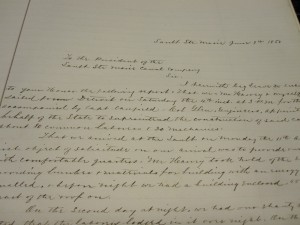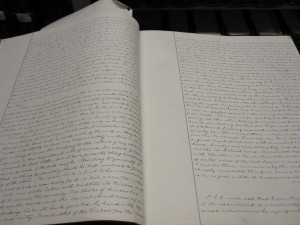A collection discovered during the current NHPRC project includes records of the Sault St. Marie Canal Company, aka: The St. Mary’s Falls Ship Canal Company. Ground breaking for the canal began in June of 1853, the engineer L.L. Nichols placed in entry in the ledger reporting on initial efforts for establishing housing facilities and beginning the construction.
The following information is found in the collection titled ‘The St. Mary’s Canal and Mineral Land Company Records’ Accession #115 and is part of the larger Copper Range Mining Company Records Collection

Nichols reported:
“That we arrived at the Sault on Monday the 11th am. The first object of solicitude on our arrival was to provide our laborers with comfortable quarters. Mr. Hearvey took hold of the business of providing lumber [and] materials for building with an energy seldom equaled [and] before night we had a building enclosed 55 by 22 feet [and] part of the roof on.”
“On the 8th day of June at 11 am being 48 hours from the time of our arrive we broke ground for the canal.”

A quote from the second report indicates the expectations and challenges faced by the engineers and their progress.
“It is now nine months since operations commenced here, and it may be well to take a retrospective review as well as a prospective view of the work contracted to be completed in our year and twenty days from this time, or about 22 months from the the time of breaking ground. There was then 230,000 yards of earth and rock-excavation to be done above and below water. There is now less than 88,000 yards remaining.”
-Excerpt from Engineer L.L. Nichols report dated 14 March 1854
The ledger also provides interesting information on the growth and development of the Upper Peninsula, a Memorium addressed to Congress and the House of Representative in 1854 calls for the state to construct roads in the Upper Peninsula. Issues cited for the necessity of the roads included the growing Mineral District (Copper Range) and Iron District combined with the construction of the canal increasing Lake Superior traffic.